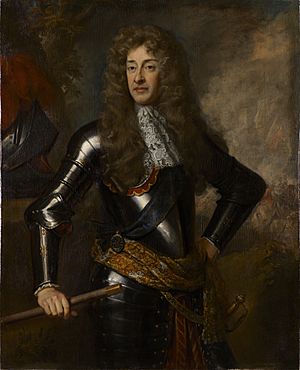Wincanton Skirmish facts for kids
Quick facts for kids Wincanton Skirmish |
|||||||
|---|---|---|---|---|---|---|---|
| Part of the Glorious Revolution | |||||||
 James II (Kneller) |
|||||||
|
|||||||
| Belligerents | |||||||
English Williamites |
|||||||
| Commanders and leaders | |||||||
| Strength | |||||||
| 120+ | 30 + | ||||||
| Casualties and losses | |||||||
| 5+ | 12 killed 8 prisoners |
||||||
The Wincanton Skirmish was a small fight that happened on 20 November 1688. It was part of a bigger event called the Glorious Revolution. In this skirmish, a small group of soldiers from the English Royal Army fought against a group from the Dutch Army. The fight took place in the town of Wincanton in Somerset, England. This event was one of the few times actual fighting happened during the Glorious Revolution, which is sometimes called the "Bloodless Revolution" because there wasn't much violence.
Contents
What Led to the Skirmish?
In 1688, William of Orange, who was a Dutch leader, landed in England with his army. He wanted to take the throne from King James II. King James's army gathered on Salisbury Plain to stop William.
Colonel Patrick Sarsfield was a very loyal officer to King James. At this time, many other commanders were not trusted. Reports came in that William's forces were near Bruton, close to Wincanton. General Percy Kirke, Sarsfield's commander, told him to take a patrol and check it out.
The Fight at Wincanton
On the morning of 20 November, Sarsfield left the royal camp. He had about 120 soldiers, including Horse Guards and Horse Grenadier Guards. His second-in-command was Henry Luttrell, who was also Irish. They rode to Bruton but found that the enemy had already moved to Wincanton.
The Dutch soldiers were a small group of about thirty infantry. They were sent ahead of their main army to find horses. These soldiers were Scottish troops from Hugh Mackay's regiment, serving in the Dutch Army. They were led by a Lieutenant Campbell. Their orders were to stay in Wincanton until William's main army arrived.
Local people who supported William warned Campbell that Sarsfield's men were coming. Campbell decided to set up an ambush for Sarsfield's group. He hid his men between Flingers Lane and Ireson Lane, just outside Wincanton. When Sarsfield's cavalry approached, Campbell wasn't sure if they were enemies or deserters. He shouted to them, asking who they supported. Both sides then started shooting.
Lieutenant Campbell was killed in the fight. Even though Sarsfield's men had more soldiers, the Scottish troops were hidden well. Their shots hit several of Sarsfield's cavalrymen. Many of Sarsfield's soldiers got off their horses and fought on foot. They shot back and threw grenades. Henry Lutrell led some men to attack the Scottish troops from the side, making them more vulnerable.
The fighting stopped when a local man ran out of Wincanton. He falsely warned Sarsfield's men that many more Dutch soldiers were coming. This warning was a trick by a miller who supported William. Sarsfield was careful and pulled his men back, out of musket range. This allowed the remaining Scottish soldiers to escape.
Sarsfield then took control of Wincanton. He captured six prisoners and some of the horses the Scottish troops had been gathering. Several of Sarsfield's men were killed or hurt. Cornet John Webb, who later became a general, was badly wounded and had to stay in the village to recover. In total, twelve Scottish soldiers, including Campbell, died in the fight.
What Happened Next?
News of the Wincanton Skirmish quickly spread. Some reports wrongly said that a big battle had happened and that King James's forces had been defeated. After the skirmish, the Dutch Army occupied Wincanton, and William spent a night at a house there.
The Wincanton Skirmish and the later Battle of Reading were the only two armed clashes in 1688. People expected a major battle between the two armies, but it never happened. Many of King James's officers left his side and joined William. Because of this, James ordered his army to retreat to London. His army slowly fell apart along the way and was finally disbanded. William was able to enter London without a big fight. King James then left England, and William and his wife were crowned as the new rulers.
Patrick Sarsfield later became famous for fighting for James during the Williamite War in Ireland (1689–91).
Remembering the Skirmish
The Orange Way is a long walking path created in 2003. It follows the route William of Orange took from Devon to London. This path goes through Wincanton, helping people remember the events of the Glorious Revolution.

